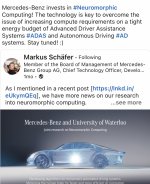Our VISION EQXX has won an AutoVision Award in the category “PR – Best Use of Stunts and Event”.
The event in question was the technology programme’s third long-distance road trip over 1,000+ kilometres on a single charge. It travelled 1,010 km through the Arabian Desert from the Mercedes-Benz Center in Riyadh, Saudia Arabia to our Brand Center in Dubai, UAE. The VISION EQXX delivered exceptional power consumption of 7.4 kWh/100 km (8.4 mi/kWh), equating to around 0.9 l/100 km or 282 MPGe for a petrol-fuelled vehicle.
There were two main reasons for doing this road trip in the Middle East.
The first was technical – to maximise efficiency in all areas and examine system performance under extreme, real-life desert conditions.
The second reason was, in fact, public relations – with its compact dimensions and sleek proportions, the VISION EQXX drew intense interest. In that respect, it was a highly desirable ambassador for long-range electric mobility in part of the world where charging infrastructure is still sparse.
It seems that the jury for the AutoVision Awards agree!




